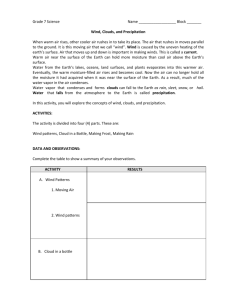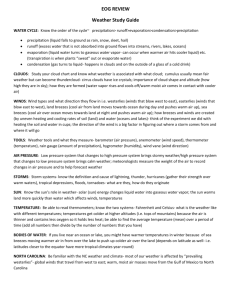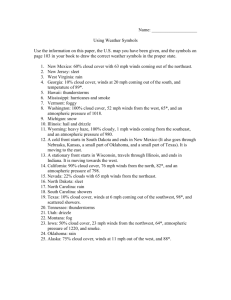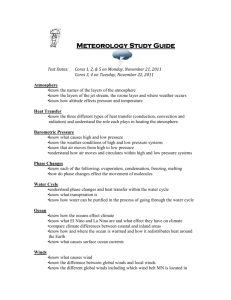Storms and Weather Forecasting
advertisement
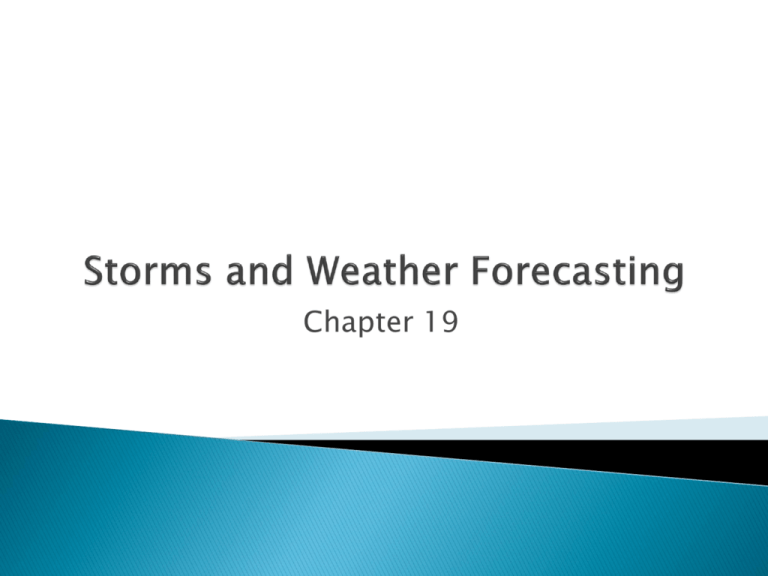
Chapter 19 Result of intense convection Associated with heating Earth’s surface ◦ During spring, summer, and fall Three-stage life cycle: ◦ Beginning stage– formation of cumulus cloud Rapid heating during day, warm air rises Cools, water vapor condenses, clouds form Clouds get bigger Small-scale convection cells form Draw in air from surroundings Form winds at surface Rapid vertical development ◦ 26,000 feet in 15 minutes; base 6 miles Convection intensifies, creates strong winds Rising air creates strong updrafts Causes water droplets/ice crystals to form ◦ Clump together to form precipitation Height of cloud reaches 7 or more miles Produces heavy precipitation Known as a cumulonimbus cloud Mature phase ◦ Strong updrafts and downdrafts of wind intensify Cause separation of lighter ice crystals at top Heavier rain at lower part of cloud Ice crystals become positively charged Hail becomes negatively charged Large electrical potential formed-released as lightning Electrical discharge of more that 100 million volts Heats air to about 45,000° F Cool air expands and creates thunder Lightning can travel: ◦ Cloud-> cloud cloud-> ground cloud-> air ◦ All are potentially dangerous Dissipating stage ◦ Strong convection that formed the thunderstorm dissipates ◦ Decline in winds and rain ◦ Skies clear Spiraling column of air contacting the ground Form at the base of thunderstorms ◦ When steep pressure gradient develops Result of strong convection Produce visible swirling air called funnel clouds Composed of rapidly moving dust and debris Produce speeds up to 300 mph Usually last only a few minutes ◦ Some up to 2 hours Tornadoes over water form a water spout Waterspouts and tornadoes move 30 to 75 mph Violent storm associated with large lowpressure system ◦ Also called a cyclone Rotate counterclockwise in the Northern Hemisphere Winds spiral inward Form over the Atlantic Ocean near the equator Low pressure moves over ocean to the USA ◦ Picks up energy/moisture from warm water ◦ Called a tropical disturbance winds less than 20 mph As it moves over warm ocean intensifies ◦ Becomes tropical depression- winds 21 to 39 mph Clouds thicken and rotate around the center ◦ Called tropical storm-winds 40 to 70 mph When sustained winds reach 74 mph ◦ Called a hurricane in the Atlantic Ocean ◦ Winds greater than 250 mph ◦ Winds move inward and move counterclockwise High winds cause pile up of water ahead ◦ Called a storm surge ◦ Can be as high as 16 feet Intensity measured- Saffir-Simpson scale ◦ Measures pressure, wind speed, and storm surge ◦ Scale of 1 to 5- 5 highest intensity In Pacific Ocean called a typhoon Three main steps: ◦ Gather current weather information ◦ Record information on charts and maps Or either computer models ◦ Charts, maps, and computer models analyzed Weather is predicted or forecasted Data gathered from almost 1,000 weather stations Data is recorded each hour ◦ ◦ ◦ ◦ Surface air temp Barometric pressure Cloud cover Wind speed ◦ ◦ ◦ ◦ Dew point Precipitation Visibility Wind direction Plotted every three hours- coded form Displayed on maps using station model ◦ Usually shows: ◦ Location of high- and low- pressure systems ◦ Temperatures ◦ Fronts ◦ Precipitation Surface temperature maps created using isotherms ◦ Lines that connect equal values of temperature Can also be created using isobars ◦ Lines connecting value of equal pressure Can be generated at different levels in the atmosphere Refer to Pg. 394 in your textbook Divided into two categories: ◦ Long-term ◦ Short-term ◦ Short-term are reliable up to 6 hour ◦ Long- term– a few days, weeks, or months out More difficult to make Refer to Pg. 395 in your textbook Radar extremely successful over past 20 years ◦ Reflected radio waves off clouds and precipitation ◦ Locates poor weather ◦ Up-to-date radar images on Internet ◦ Can also differentiate forms of precipitation ◦ Predicts where snow/freezing rain may form Simple observations can also predict weather ◦ Low barometric air pressure-poor weather ◦ Rise in barometric pressure- good weather ◦ Type of clouds: Cumulus- incoming thunderstorms Stratocumulus- approaching warm front and precipitation Clearing skies in winter- drop in temp
